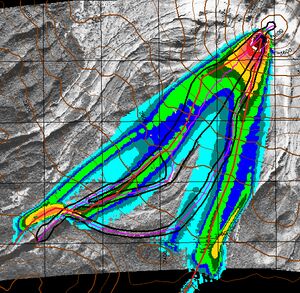Software:TITAN2D
 Comparison of field observation and simulations for flows at Colima volcano | |
| Developer(s) | Geophysical Mass Flow Group |
|---|---|
| Stable release | 2.0.0
/ July 21, 2007 |
| Operating system | Unix-like |
| Type | Geoflow Simulator |
| License | NCSA Open Source License |
| Website | www |
TITAN2D is a geoflow simulation software application, intended for geological researchers. It is distributed as free software.
Overview
TITAN2D is a free software application developed by the Geophysical Mass Flow Group at the State University of New York (SUNY) at Buffalo. TITAN2D was developed for the purpose of simulating granular flows (primarily geological mass flows such as debris avalanches and landslides) over digital elevation models (DEM)s of natural terrain. The code is designed to help scientists and civil protection authorities assess the risk of, and mitigate, hazards due to dry debris flows and avalanches. TITAN2D combines numerical simulations of a flow with digital elevation data of natural terrain supported through a Geographical Information System (GIS) interface such as GRASS.
TITAN2D is capable of multiprocessor runs. A Message Passing Interface (MPI) Application Programming Interface (API) allows for parallel computing on multiple processors, which effectively increases computational power, decreases computing time, and allows for the use of large data sets.
Adaptive gridding allows for the concentration of computing power on regions of special interest. Mesh refinement captures the complex flow features that occur at the leading edge of a flow, as well as locations where rapid changes in topography induce large mass and momentum fluxes. Mesh unrefinement is applied where solution values are relatively constant or small to further improve computational efficiency.
TITAN2D requires an initial volume and shape estimate for the starting material, a basal friction angle, and an internal friction angle for the simulated granular flow. The direct outputs of the program are dynamic representations of a flow's depth and momentum. Secondary or derived outputs include flow velocity, and such field-observable quantities as run-up height, deposit thickness, and inundation area.
Mathematical Model
The TITAN2D program is based upon a depth-averaged model for an incompressible Coulomb continuum, a “shallow-water” granular flow. The conservation equations for mass and momentum are solved with a Coulomb-type friction term for the interactions between the grains of the media and between the granular material and the basal surface. The resulting hyperbolic system of equations is solved using a parallel, adaptive mesh, Godunov scheme. The basic form of the depth-averaged governing equations appear as follows.
The depth-averaged conservation of mass is:
- [math]\displaystyle{ {\underbrace{\partial h \over \partial t}}_{ \begin{smallmatrix} \text{Change}\\ \text{in mass}\\ \text{over time} \end{smallmatrix}} \begin{smallmatrix} \text{Total spatial}\\ \text{variation of}\\ \text{x,y mass fluxes} \end{smallmatrix}} = 0 }[/math]
The depth-averaged x,y momentum balances are:
- [math]\displaystyle{ {\underbrace{\partial \overline{hu} \over \partial t}}_{ \begin{smallmatrix} \text{Change in}\\ \text{x mass flux}\\ \text{over time} \end{smallmatrix}} \begin{smallmatrix} \text{Total spatial variation}\\ \text{of x,y momentum fluxes}\\ \text{in x-direction} \end{smallmatrix}} = \underbrace{-hk_{ap} \sgn \left({\partial u \over \partial y}\right){\partial hg_z \over \partial y}\sin \phi_{int}}_{ \begin{smallmatrix} \text{Dissipative internal}\\ \text{friction force}\\ \text{in x-direction} \end{smallmatrix}} - \underbrace{{u \over \sqrt{u^2+v^2}}\left[ g_zh\left(1+{u^2 \over r_xg_z}\right) \right]\tan \phi_{bed}}_{ \begin{smallmatrix} \text{Dissipative basal}\\ \text{friction force}\\ \text{in x-direction} \end{smallmatrix}} + \underbrace{g_xh}_{ \begin{smallmatrix} \text{Driving}\\ \text{gravitational}\\ \text{force in}\\ \text{x-direction} \end{smallmatrix}} }[/math]
- [math]\displaystyle{ {\underbrace{\partial \overline{hv} \over \partial t}}_{ \begin{smallmatrix} \text{Change in}\\ \text{y mass flux}\\ \text{over time} \end{smallmatrix}} + \underbrace{{\partial \overline{huv} \over \partial x} + {\partial \over \partial y} \left( \overline{hv^2}+{1 \over 2}{k_{ap}g_zh^2}\right)}_{ \begin{smallmatrix} \text{Total spatial variation}\\ \text{of x,y momentum fluxes}\\ \text{in y-direction} \end{smallmatrix}} = \underbrace{-hk_{ap} \sgn \left({\partial v \over \partial x}\right){\partial hg_z \over \partial x}\sin \phi_{int}}_{ \begin{smallmatrix} \text{Dissipative internal}\\ \text{friction force}\\ \text{in y-direction} \end{smallmatrix}} - \underbrace{{v \over \sqrt{u^2+v^2}}\left[ g_zh \left(1+{v^2 \over r_yg_z}\right) \right]\tan \phi_{bed}}_{ \begin{smallmatrix} \text{Dissipative basal}\\ \text{friction force}\\ \text{in y-direction} \end{smallmatrix}} + \underbrace{g_yh}_{ \begin{smallmatrix} \text{Driving}\\ \text{gravitational}\\ \text{force in}\\ \text{y-direction} \end{smallmatrix}} }[/math]
See also
- Geologic hazards
- Lahar
- Pyroclastic flow
- Debris flow
- landslides
References
- Titan2D User Guide, Release 2.0.0, 2007.07.09; Geophysical Mass Flow Group, University at Buffalo (http://www.gmfg.buffalo.edu).
- A.K. Patra, A.C. Bauer, C.C. Nichita, E.B. Pitman, M.F. Sheridan, M. Bursik, B. Rupp, A. Webber, A. Stinton, L. Namikawa, and C. Renschler, Parallel Adaptive Numerical Simulation of Dry Avalanches Over Natural Terrain, Journal of Volcanology and Geophysical Research, 139 (2005) 1-21.
- E.B. Pitman, C.C. Nichita, A.K. Patra, A.C. Bauer, M.F. Sheridan, and M. Bursik, Computing Granular Avalanches and Landslides, Physics of Fluids, Vol. 15, Number 12 (December 2003).
- M.F. Sheridan, A.J. Stinton, A. Patra, E.B. Pitman, A. Bauer, C.C. Nichita, Evaluating Titan2D mass-flow model using the 1963 Little Tahoma Peak avalanches, Mount Rainier, Washington, Journal of Volcanology and Geophysical Research, 139 (2005) 89–102.
- E.B. Pitman, C. Nichita, A. Patra, A.C. Bauer, M. Bursik and A. Webber, A Numerical Study of Granular Flows on Erodible Surfaces, March 24, 2003.
- B. Rupp, M. Bursik, A. Patra, B. Pitman, A. Bauer, C. Nichita, R. Saucedo, J. Macias, 2003,Simulation of Pyroclastic Flows of Colima Volcano, Mexico, Using the TITAN2D Program, AGU/EGS/EUG Spg Meet., Geophysical Research Abstracts, 5, 12857.
- E. Munoz, D. Palacios, L. Namikawa, M. Sheridan, C. Renschler, Contrast Between Computer Simulations and Field Observation of Popocatepetl Lahars, Geophysical Research Abstracts, Vol. 6, 04599, 2004, European Geosciences Union.
External links
- Geophysical Mass Flow Group (TITAN2D Distribution Site)
- Titan2d-mod (released in 2016, a version modified from titan 3.0.0, 2011)
- Processors
 |

